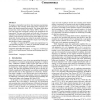678 search results - page 51 / 136 » Dependent Types for Program Understanding |
ITICSE
1996
ACM
14 years 1 months ago
1996
ACM
This paper describes two ways we have integrated algorithm animations into several computer science courses. First, we use previously existing animations during lectures to aid in...
FAC
2008
13 years 9 months ago
2008
Abstract. Slicing is a program analysis technique that was originally introduced to improve program debugging and understanding. The purpose of a slicing algorithm is to remove the...
UM
2007
Springer
14 years 3 months ago
2007
Springer
Increasingly, online systems depend on user contributions such as posts, ratings, tags, and comments. Many of these systems wish to encourage broader participation or the contribut...
ICSE
2001
IEEE-ACM
14 years 1 months ago
2001
IEEE-ACM
Dynamic analysis is based on collecting data as the program runs. However, raw traces tend to be too voluminous and too unstructured to be used directly for visualization and unde...
TLDI
2009
ACM
14 years 6 months ago
2009
ACM
We propose a dependent type theory that integrates programming, specifications, and reasoning about higher-order concurrent programs with shared transactional memory. The design ...

